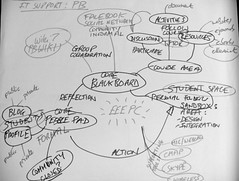If your CIO isn't asking you for money, she's not being a good soldier; she's just not doing her job.
IT Value | July 17, 2012 | CFO.comSusan Cramm
There are quite a few companies who have tried to cut their way to IT success over the past five years and are starting to regret it.
 … Companies that have delayed investments – in people and technology – are finding that they are now at a competitive disadvantage. New competitors, without the burden of legacy IT environments …, are leveraging low-cost, fast-cycle disruptive technologies. These fast-moving competitors are pushing industry incumbents to build new IT-enabled capabilities or risk falling farther behind.
… Companies that have delayed investments – in people and technology – are finding that they are now at a competitive disadvantage. New competitors, without the burden of legacy IT environments …, are leveraging low-cost, fast-cycle disruptive technologies. These fast-moving competitors are pushing industry incumbents to build new IT-enabled capabilities or risk falling farther behind.Is your company falling victim to this save now, pay later strategy? Consider the following:
1) Has your company reduced IT spending as a percent of revenue over the past 5 years?
2) Does your company have the IT capability needed to exploit new technologies and reshape the company’s operating model, creating “smart” products and services, and enhancing its relationship with customers and suppliers?
If you answered “yes” to the first and “no” to the second, you need to engage with your CIO in a conversation about treating IT as an investment that builds rather than destroys IT capability and value. …
… IT should be managed as an investment, not as an expense. … In my research, business and IT executives estimate the expected return from their potential sustaining investments at 30%, and their innovative investments at 80%.
 |
| Technology Map - Tutornet (Photo credit: steven w) |
… A large portion of IT spending (on average 70%) is required to keep your existing technology up and operating safely. Lights-on costs increase as your company grows, as new security risks are identified and new regulations imposed, as applications are implemented, and as the technological foundations become more complex. The only way to save money on lights-on costs going forward is to invest money in order to reduce the total number of technologies you support while adopting new technologies that can do more for less (such as server virtualization and performance monitoring, among others).
CIOs that are doing their jobs … will do so (one hopes and should expect) in a responsible manner, in partnership with you and other executives to ensure that the company is:
1) Realizing value from IT-enabled business investments;
2) Driving down “lights-on” costs – and technology complexity – making it easier to introduce new changes, more quickly;
3) Building the skills necessary to lead IT-enabled change and leverage external suppliers – in and out of IT.
…[Conventional] wisdom has long held that the competent CIO doesn’t negatively impact general and administrative expense margins and always delivers their share of any requested G&A cuts. But this conventional wisdom needs to change. IT isn’t an overhead expense; it’s an organizational asset that needs to be managed as an investment with a steady hand and an eye fixed on enhancing the company’s long term competitive capabilities and options.
Susan Cramm is an executive coach and president of Valuedance, an executive-coaching and leadership-development firm specializing in information technology. She is a former CIO and CFO, and is the author of The 8 Things We Hate About IT: How to Move Beyond the Frustrations to Form a New Partnership with IT (Harvard Press). Susan can be reached at http://www.valuedance.com/.










No comments:
Post a Comment